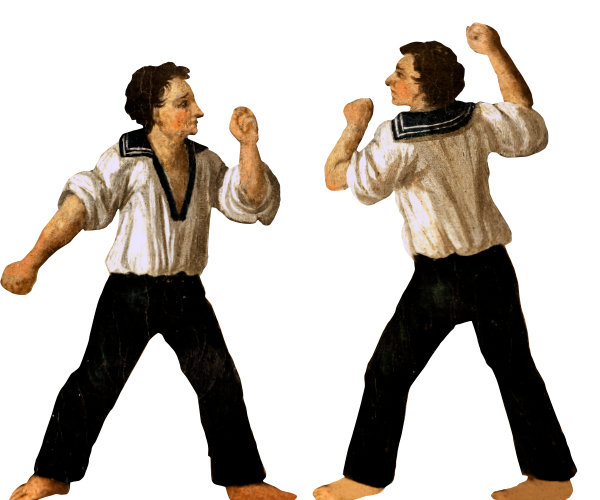
Sailors in a bout of joc maonès
Two sailors fighting in the port, attracting attention from all around.
Is it a fight? Women are crying!
But the onlookers should not fret: both the raised position of their hands and their foot position correspond with the plantada, the basic starting position of the joc maonès combat sport. This type of combat was introduced to the port of Maó by either the English or the French during the 18th century. Similar to the French savate, this sport involves hitting, kicking and tripping, and has a set of rules of its own. A tradition that survives to this day and is still practiced in Maó.
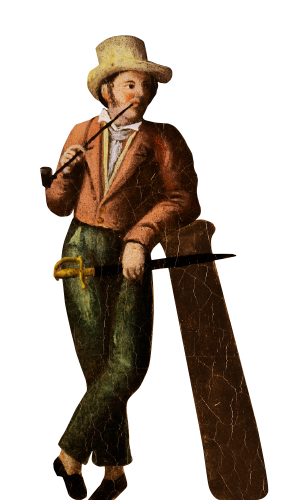
Man, pipe and sword
A rather relaxed gentleman, smoking Aztec tobacco from a reed pipe while overseeing the weighing of wheat. The boat will be loaded with grain for transport to Barcelona, quite the business!
He is bourgeois, of course, and how he values being fashionable! Long trousers with a short jacket and shirt with waistcoat and handkerchief, a predecessor of the tie. But it is not only his clothes that give him away: he is wearing a top hat and carrying a sword! This weapon was carried to demonstrate social status, and his acquaintances with stores down in the port of course did the same.
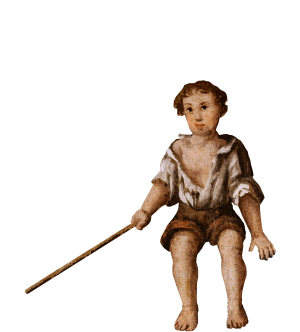
A boy fishing
A boy fishing, but out of necessity or just to pass the time? Children who worked from a young age were artisans, farmers or fishermen. At times, they would also look for ways to help their family subsist, and the rockfish that could be caught in the port was certainly tasty. And if they could find some extra work at one of these stores, the bit of extra money was welcome. Once back in town, he would play outside, as there were many games to be played, like marbles or hopscotch, or any game he and his friends might make up! Free time was not an issue, as he was not sent to school. That was reserved for the wealthy.

An uneasy Franciscan
The Franciscan friar, from a family of artisans, left everything behind to serve the city of Maó and take his vow of poverty; as seen by his humble habit and avarca sandals, like those worn by local farmers. Around his waist, he wears a Franciscan cord, with the five knots that symbolise the five wounds left on the body of Jesus Christ from his crucifixion.
But he appears uneasy: news from the Spanish mainland is worrisome and his convent, Sant Francesc, located atop the cliffs over the port, is in danger of being disentailed and the friars, expelled. The Carmelites were also nervous, as some residents of Maó had already threatened to confiscate all the furniture and ornaments from the Convent del Carme monastery.
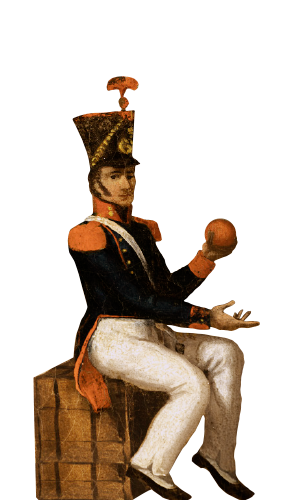
Spanish infantry soldier
Finally on land. The ship flying the Spanish flag was docking and the warden of the lazaretto quarantine hospital had declared the ship free from disease.
And how they longed to taste fresh fruit after so many days at sea! There are many uniformed soldiers and seafarers, all of whom would normally recognise one another. But on that day, apart from the Spaniards, the only identifiable soldier was the occasional Frenchman, thanks to his bicorne hat.
EThe infantry sergeant longed to reach the Port of Maó; it was buzzing with activity… and spirits. He was proud to flaunt his summer uniform with its insignias, and it was impeccable: white trousers and blue justacorps. His shoes were well shined, having polished them just before disembarking. The most uncomfortable feature was his shako cap, fastened just below the chin, although its flare and pompom made him visible even from the other side of the port, and he felt proud.
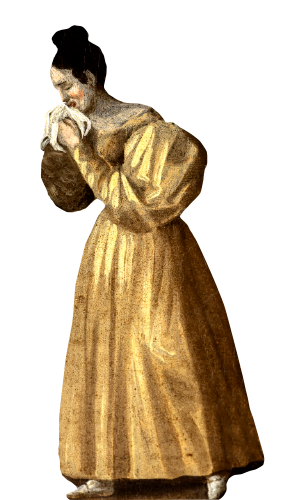
Snivelling woman
How upsetting that her beloved sailor has picked a fight. And she had worn her very best dress, the most fashionable one she had, to go for a stroll with her friends.
She was so fond of its French style, and it hugged her body so nicely and was low-cut, while still quite respectable. And its puffy sleeves that were all the rage! She wore her white stockings, the new ones, and high-heeled shoes. Her sister had done her hair: pulled back and in a bun, and of course her silk handkerchief that her mother had given her.
